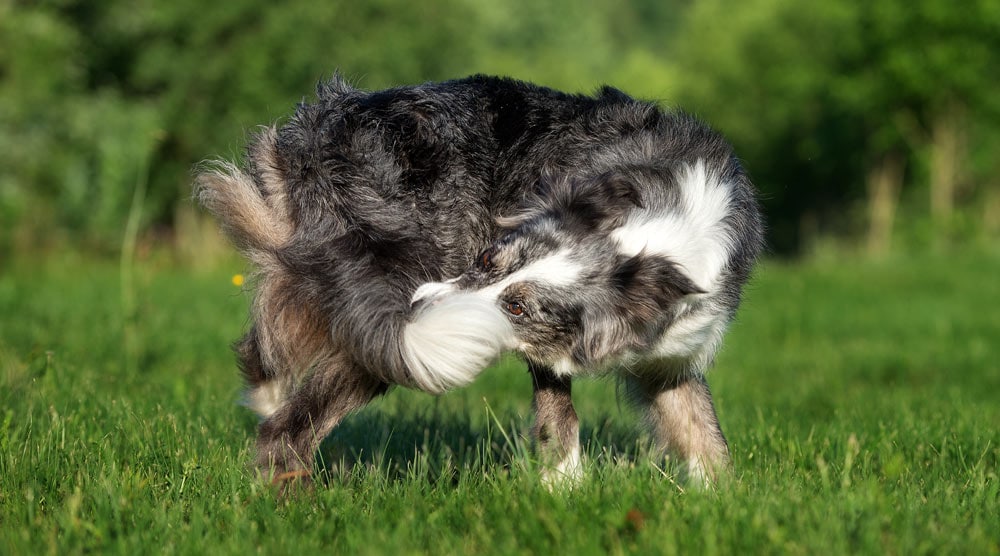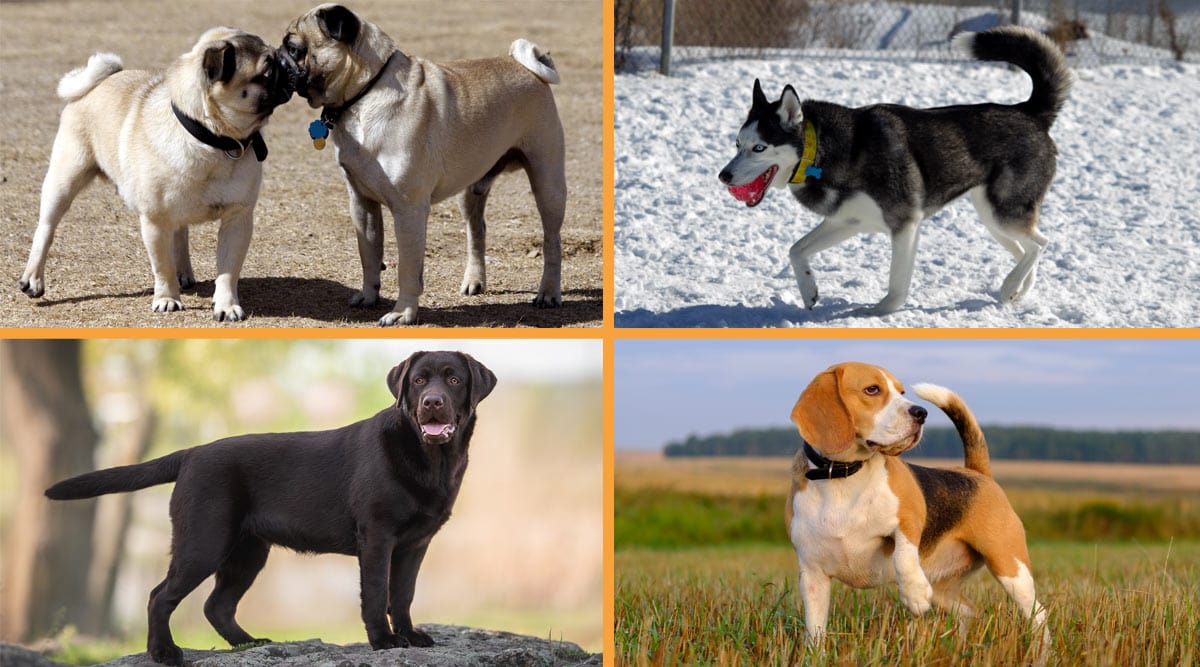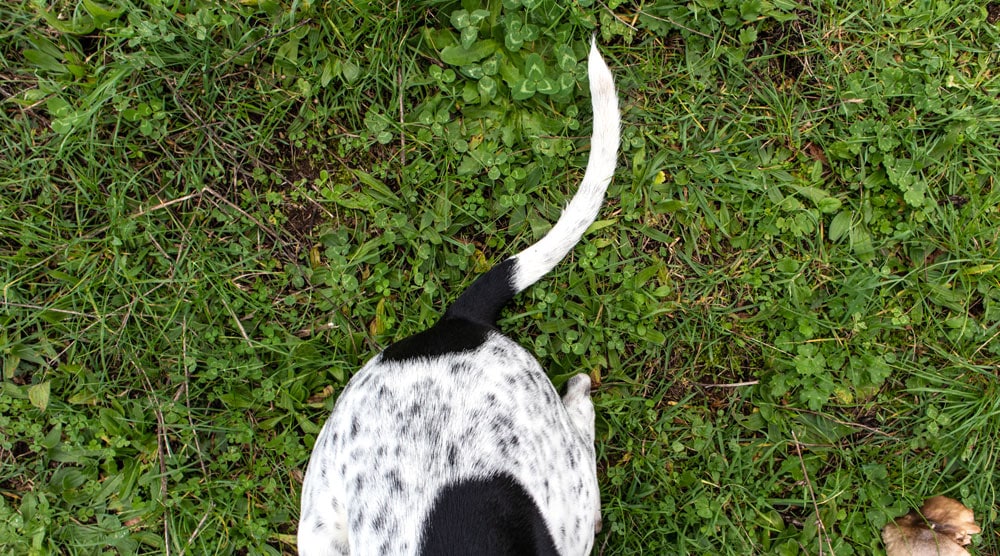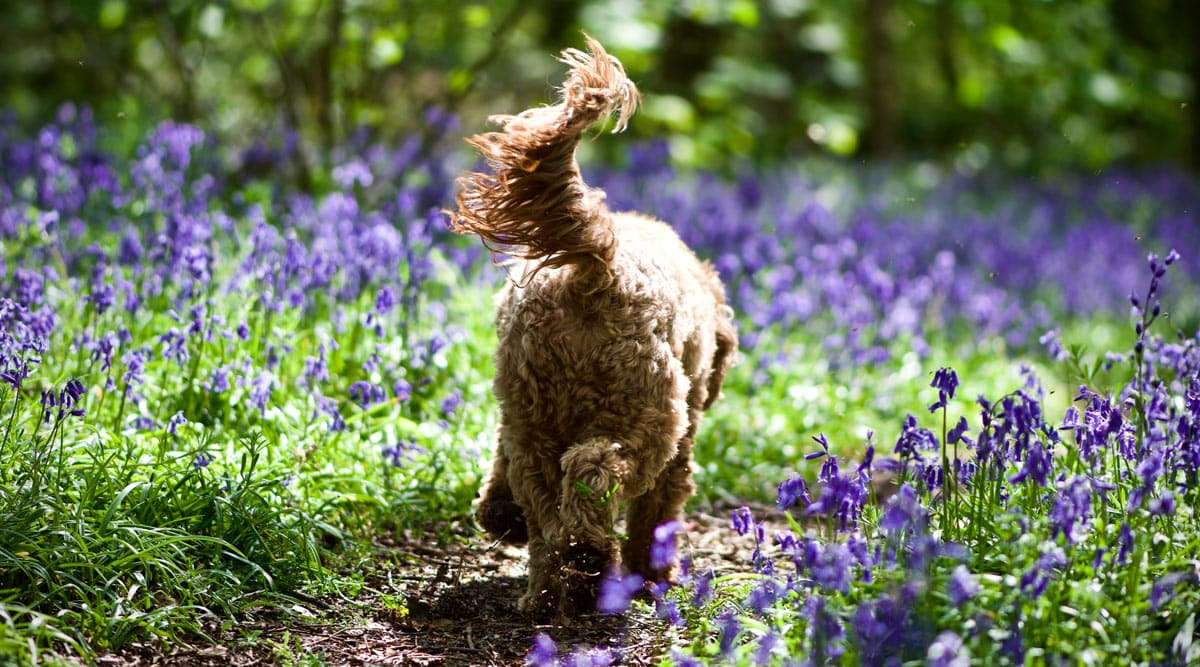When does a dog’s tail chasing move from cute to concerning? This guide will help you understand why dogs chase their tails, whether it’s due to health issues, boredom, or even genetics.
We’ll also provide you with positive training strategies to reduce excessive tail chasing. This knowledge is key to ensuring your furry friend’s happiness and well-being. Let’s dive in!
Contents
- Is Tail Chasing Worrying Or Just Playful?
- Behavioral Reasons for Tail Chasing
- Health Reasons for Tail Chasing
- External Parasites (Including Fleas and Ticks) Might Cause Tail Biting
- Internal Parasites Can Also Lead to Tail Chasing
- Allergies Can Trigger Tail Chasing
- Genetics May Influence Tail Chasing Behaviour
- Impacted Anal Glands Can Lead to Tail Chasing
- Pain Due to Injury or Neurological Issues Can Prompt Tail Chasing
- Lack of Nutrients May Make Excessive Tail Chasing More Likely
- Should I Stop My Dog from Chasing His Tail?
- How to Diagnose the Cause of Excessive Tail Chasing
- How to Discourage Tail Chasing Using Positive Methods
- Related Questions
Is Tail Chasing Worrying Or Just Playful?
Tail chasing in dogs can be both normal play behavior and a potential sign of distress, depending on factors like frequency, duration, and intensity.
For example, puppies often engage in tail chasing as they get to know their bodies. This is harmless and usually not a cause for concern. In adult dogs, the occasional whirl of tail chasing is also considered normal canine behavior.
However, if your dog’s tail chasing becomes frequent, or if it leads to self-inflicted harm, then it’s likely not just innocent play. Excessive tail chasing can indicate an underlying issue, such as anxiety, OCD, or a medical issue.

Perception of Tail Chasing Amongst Dog Owners
There was an interesting study conducted in 2011. Researchers found that tail-chasing dogs were 6.5 times more likely to be labelled as “stupid” or “funny” by their owners. This statistic underscores that many dog parents may not understand excessive tail chasing can be a sign of distress or illness.
Behavioral Reasons for Tail Chasing
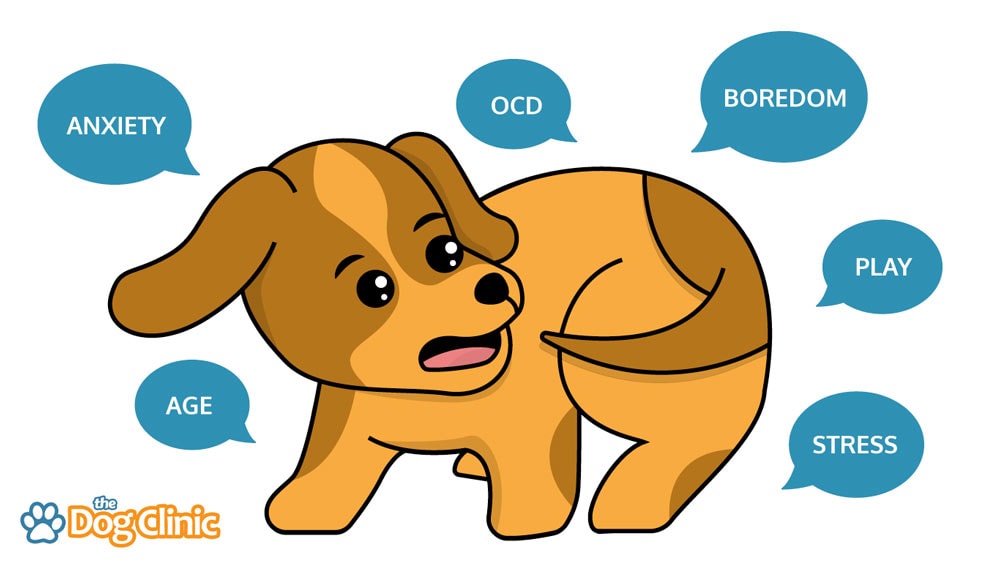
Tail chasing might appear foolish, but it’s not a sign of stupidity. It’s also usually not because the dog doesn’t realise the tail is attached to its body, though this may be true with young puppies.
The actual reasons for this behaviour are more complex. Let’s start with some common behavioral reasons for tail chasing.
Tail Chasing Can Sometimes Just Be Your Dog Playing
As we’ve already mentioned, occasional tail chasing is probably nothing to worry about.
Tail chasing can be a form of play, especially with puppies and young dogs. At this age, it’s a common way for dogs to explore their bodies and capabilities. Adult dogs may tail chase for fun too, although it’s less common.
When tail chasing is part of play, it’s typically sporadic and doesn’t interfere with the dog’s daily activities or health. The activity shouldn’t last for extended periods, and the dog’s body language should be relaxed before and after.
Boredom is a Common Cause of Chasing Tails
A common cause of excessive tail chasing is boredom, particularly if the dog isn’t getting enough physical or mental stimulation. In this situation, tail chasing is a way to expend pent-up energy or alleviate frustration.
To reduce tail chasing due to boredom, provide more interactive toys, mental challenges, and physical exercise. Additionally, it’s important to give your dog plenty of positive attention throughout the day and avoid leaving them alone for long durations.
Anxiety or Stress Might Cause Tail Chasing
Dogs may chase their tails when feeling anxious or stressed. This activity helps distract the dog from whatever is causing anxiety. In the world of dog training, this is known as a displacement behavior.
Various stressors can trigger tail chasing, such as a change in environment, loud noises, or separation from the owner. Alongside tail chasing, watch for other stress signals such as excessive panting, pacing, or restlessness.
The first step to reducing stress is to identify the trigger. Once you know what’s causing your dog to become stressed, take steps to remove it from their environment. If that’s not possible, reducing the intensity of the trigger can also help.
Tail Chasing Can Become a Reinforced Behavior
If dogs receive positive reinforcement for tail chasing, they may learn that it’s a great way to get attention. Even negative attention, such as reprimands, can also reinforce the behavior if the dog is seeking interaction.
You should never punish your dog for unwanted behaviour. Instead, gently interrupting the chasing and rewarding an alternative action can help break this cycle.
Make sure everyone in the household understands that tail chasing isn’t something to be encouraged. If one member of the family finds it fun and provides positive reinforcement, it’ll make the habit difficult to break.
Note: Tail chasing can also become a self-reinforcing behavior. For instance, if tail chasing helps the dog cope with anxiety, the dog might start doing it in other situations. Similarly, if tail chasing and biting relieves itchiness from a medical condition, the dog might repeat the behavior even after they are cured.
Tail Chasing Can be a Compulsive Behavior (OCD)
Obsessive-compulsive disorder (OCD) affects both dogs and humans. It happens when a dog performs behaviors in an extreme and repetitive manner, to the point where it impacts their quality of life. Tail chasing is a common form of this disorder.
During compulsive tail chasing, dogs might be less responsive to cues or attempts to get their attention. It’s important to understand that this doesn’t mean the dog is being “naughty” or “disobedient.” Instead, the dog may not be able to stop the behaviour, or may not even hear you talking.
Over time, dogs with OCD often cause injury to their tails from constant chasing and biting. We’ve even heard of cases where dogs are unable to perform basic activities, such as going on a walk, without obsessively chasing their tail.
While any dog can develop OCD, it’s more common in those who have experienced trauma, physical abuse, lack of socialization, or deprivation of essential needs. Some breeds, such as German Shepherds and Doberman Pinschers, also seem to be more susceptible to compulsive behaviors.
To address canine OCD, a multidisciplinary approach is often required, involving both a veterinarian and a behaviorist. Medical diagnosis is essential, as medication may be needed to manage the symptoms and enhance the dog’s quality of life. Consulting with a certified behaviorist is also vital, as they can develop a behavior modification program and recommend environmental changes to help the dog.
Age Can Make This Behaviour More Likely
As we discussed earlier, puppies often engage in tail chasing as a form of play or exploration.
However, it can be challenging to tell the difference between typical puppy play and the start of excessive tail chasing. Many puppies chase their tails, but excessive cases usually start to develop around 3-6 months old too. So, it’s important to monitor your puppy’s tail chasing for signs of compulsive behavior.
At the other end of the age spectrum, senior dogs can experience canine cognitive dysfunction (CCD). This is similar to dementia in humans, and can lead to unusual or compulsive behaviors, such as tail chasing or chewing.
Note: Research indicates that puppies separated from their mothers early are more likely to develop excessive tail chasing. This is possibly due to the trauma and stress of early separation.
Health Reasons for Tail Chasing
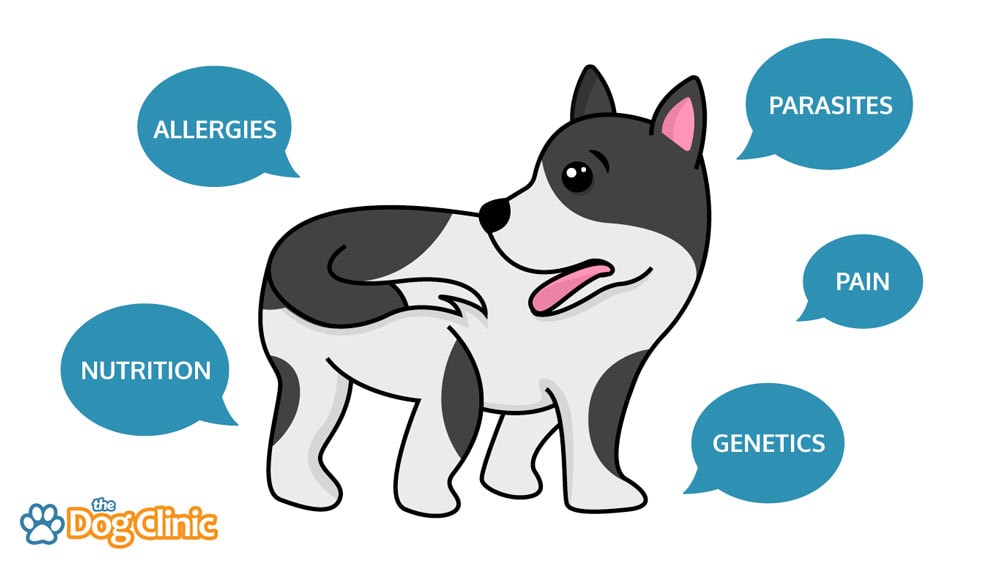
Any sudden change in your dog’s behavior, including an increase in tail chasing, warrants a check-up with a veterinarian. Dogs often chew or lick their tail to alleviate discomfort, so tail chasing could be a sign of a health issue. Let’s take a closer look at some of the most common medical reasons for tail chasing.
External Parasites (Including Fleas and Ticks) Might Cause Tail Biting
External parasites can cause itching and discomfort around the tail area. This can force dogs to chase and bite their tails in an attempt to get relief.
Fleas are the most common culprits, as they cause intense itching. Ticks can also get lodged into the skin, leading to irritation and needing to scratch the area.
Regular grooming and preventative treatments can help prevent parasite infestations. If you notice your dog is excessively chasing or biting their tail, visiting the vet is important.
Internal Parasites Can Also Lead to Tail Chasing
Internal parasites can cause itching around the rectum. This might lead to tail chasing, as the dog attempts to alleviate the discomfort.
Tapeworms are a common example. These parasites can migrate through the intestines and out of the rectum, which can cause a strong urge to itch the area.
Other symptoms of internal parasites include diarrhea, scooting, lethargy, and weight loss. If you notice these symptoms, it’s important to visit a vet for an accurate diagnosis. Regular checkups and deworming treatments are also important.
Allergies Can Trigger Tail Chasing
Allergies to certain foods or environmental factors can cause itching and discomfort in the tail area. This can lead to tail chasing and biting.
Other symptoms of an allergy include:
- Red and inflamed skin
- Sneezing
- Hives
- Diarrhea
- Vomiting
If untreated, the biting and scratching may cause tail wounds or hair loss. Allergies can also be very uncomfortable for your pet. So, you should always visit a vet if you suspect your dog is suffering from an allergy.
Genetics May Influence Tail Chasing Behaviour
While any dog can develop tail-chasing behaviors, research has shown that certain breeds, like German Shepherds and Bull Terriers, have a genetic predisposition. Owners of these breeds should monitor their dogs closely for signs of excessive or harmful tail chasing.
Impacted Anal Glands Can Lead to Tail Chasing
Dogs have an anal gland on either side of their anus. If these glands become impacted or infected, they can cause discomfort, causing dogs to chase their tails.
Regular grooming and vet check-ups can help detect and treat this issue early. A healthy and balanced diet can also help.
Pain Due to Injury or Neurological Issues Can Prompt Tail Chasing
Pain in the tail or hindquarters, whether from injury or a neurological issue, can cause dogs to chase their tails. This is often the dog’s attempt to chew or bite the tail to get relief.
Tail injuries can come in many forms. A broken dog tail, for example, often causes swelling and the tail to hang limply. It’s also common for dogs to suffer from cuts or scrapes to the tail.
If your dog suddenly starts chasing their tail and seems in pain, a vet visit is necessary to rule out these issues. You should also visit the vet if your dog has trouble wagging his tail or you notice swelling.
Lack of Nutrients May Make Excessive Tail Chasing More Likely
In a 2012 study titled “Environmental Effects on Compulsive Tail Chasing in Dogs,” researchers discovered that dogs given vitamins and minerals were less likely to develop severe tail chasing. Specifically, dogs receiving vitamin C or vitamin B6 were significantly less likely to chase their tails.
This hints that there might be a nutritional cause in some dogs. However, this study was relatively small and observational, meaning more research is needed.
Should I Stop My Dog from Chasing His Tail?
If your dog’s tail chasing is infrequent, then it’s usually not a concern. But if the behavior is excessive, obsessive, or results in harm to your dog, you should intervene using positive reinforcement methods.
Addressing the underlying cause is crucial, as this is often the only way to stop tail chasing in the long run. The earlier the behavior is interrupted, the better the chances of successfully breaking the habit.
How to Diagnose the Cause of Excessive Tail Chasing
As we’ve already mentioned, occasional tail chasing is normal for many dogs. However, frequent or excessive tail chasing requires a consultation with a veterinarian.
This is especially important if there are other symptoms of illness, such as behavioral changes, loss of appetite, scratching, or whimpering.
You should also check your dog’s tail, hindquarters, and anal glands for signs of a problem. Don’t lift the tail directly upwards though, as this can cause discomfort. Instead, gently move it to the side.
If health issues are ruled out, a dog behaviorist can identify behavioral causes and design a training program. To help your behaviorist, try to record your dog’s tail chasing habits, including:
- The dog’s overall behavior, mood, and health. Look for signs of stress, anxiety, or physical discomfort.
- Note when the tail chasing happens and if there are any obvious triggers like noises, people, other pets, time of day, and so on.
- Environmental factors such as household changes, lack of stimulation, or extended periods of isolation.
How to Discourage Tail Chasing Using Positive Methods
If your vet has ruled out medical conditions, the following positive reinforcement strategies may help reduce tail chasing. Taking action is essential for this type of behaviour issue, as it can quickly become a difficult habit to break.
“Even if you are working on resolving the issue (with a vet or behaviourist) it’s really important that you discourage tail chasing if you see them start to do it,” says dog trainer Rebecca Morello. “This is to prevent the habit from becoming further ingrained, and also to help them feel more comfortable and calm.”
Increase Exercise and Mental Stimulation
Providing your dog with more physical exercise and mental stimulation can reduce tail chasing – especially if it’s caused by boredom or anxiety.
In particular, regular walks, playtime, interactive toys, and puzzle games can keep your dog mentally occupied and reduce the urge to chase their tail.
It’s crucial to balance the amount of exercise your dog gets, though. Over-exercising can also stress your dog, which could make tail chasing worse. If you think your dog is already getting enough exercise, you might want to consider mind-engaging activities like puzzle toys and indoor games.
Gently Interrupt Tail Chasing
It’s important to prevent tail chasing from becoming an ingrained habit. So, if you see your dog start to tail chase, try to gently interrupt it without scolding or giving your dog positive reinforcement.
“Always make sure interrupting tail chasing is done as gently and calmly as possible to avoid causing further stress and potentially making the behaviour worse,” says Rebecca Morello. “You could use a kissing noise, show them a toy to play with instead, or ask them for a different behaviour they already know (such as sit). Make sure to treat them for listening to the cue.”
“If they go straight back to tail chasing, you may need to add a longer-lasting distraction. Examples could include a lick mat, dog chew, short walk, or even just moving to a different room.”
Avoid Reinforcing the Behaviour
While interrupting tail chasing is important, you also don’t want to accidentally reinforce the behavior by giving your dog praise or attention. Even negative interactions (such as scolding or punishing your dog), might increase the likelihood of future tail chasing.
Identify and Mitigate Environmental Triggers
If there are specific triggers in your dog’s environment that seem to induce tail chasing—like certain sounds or visitors—consider ways to minimize these stimuli.
For example, if the trigger is an outdoor noise, consider playing white noise or background radio. Dogs who get stressed by visitors could also be given a quiet space to relax, away from the socialising.
Remember, if your dog’s tail-chasing habit becomes obsessive or appears to stem from anxiety, it’s crucial to seek professional help. Compulsive behaviors can be challenging to resolve, so the help of both a vet and canine behaviorist is essential.
Related Questions
Why Do Dogs Have Tails?
Dogs’ tails serve several important purposes. They aid in maintaining balance, particularly during swift running or abrupt turns. Additionally, tails act as a crucial communication tool for dogs, helping them express various emotions such as happiness, fear, or defensiveness.
Do Dogs Get Dizzy When Chasing Their Tail?
While it’s hard to definitively say, it appears that tail chasing doesn’t induce dizziness in dogs in the same way it does in humans.
Are Some Breeds More Likely to Chase Their Tail?
Certain dog breeds are predisposed to tail chasing, especially those known for high energy levels or obsessive behaviors. Two of the most common examples include Bull Terriers and German Shepherds. Nonetheless, any dog, regardless of breed, can develop tail-chasing behaviors under specific circumstances.
